NASA seems to spend a lot of time looking for and thinking of ways to divert errant asteroids that might possibly hit earth. However, they keep reassuring the public that the probability of actually being hit by an asteroid is extremely small. So why all the attention?
12 years ago, the Orlando Sentinel published this:
To David Morrison, a senior scientist at NASA, the Earth orbits the sun in a sort of cosmic shooting gallery. More than 1 million asteroids spin around the sun, and it is Morrison's job to figure out which of these bodies of rock, dust and metal could come crashing down on Earth.Well it seems either their asteroid program is just another boondoggle meant to enrich contractors in the Military Industrial Complex or they're lying. Possibly a combination of both. If we can't stop an asteroid or comet from hitting us, do you think they'll panic the public by announcing an impending collision beforehand? Do you have a personal bunker?
Right now, NASA is tracking 127 asteroids that have a very small chance of striking the planet. That number is about to get a lot higher. Stronger telescopes, and a new mandate from Congress, will allow scientists to detect thousands of smaller asteroids more likely to hit Earth. And scientists are plotting ways to stop them, from "gravity tractors" to solar ray guns. "There is no question that these will hit the Earth," says Russell Schweickart, a former Apollo astronaut who is involved in a group studying asteroids. "The question is how often we will have to do something about it." In fact, Schweickart thinks world leaders might have to do something about it very soon, within the next 15 years.
In early March, Russian, European, Japanese and American scientists held a Planetary Defense Conference in Washington to discuss the threats and plot a strategy for dealing with them. Identifying asteroids close to the Earth is the priority right now, says Dave Jonta, a conference spokesman. A large asteroid could cause what scientists call an "impact winter": a huge volume of dust gets thrown into the atmosphere, completely or partially blocking the sun's light, causing crop loss, disease and possible global starvation. And smaller asteroids could kill hundred of thousands, if not millions of people, Schweickart says.
A group of experts, scientists, diplomats and international lawyers will meet in May to confront issues such as what country will finance asteroid-destruction missions. One problem: Because of the difficulty in projecting an asteroid's orbit, scientists often can only predict the probability that a specific asteroid will hit the Earth. So international leaders might have to take action before knowing for certain what path an asteroid might take. "We may have to spend $300 million to fly a mission that, in the end, wasn't needed," Schweickart says, "but that's a lot better than living with a 10 percent chance that New York City will be hit."
I'm a climate model analyst working at a major research institute. On March 1st 2007 I received a curious email from a climate scientist, Prof. James P Kennett, of the University of California Santa Barbara addressed to a paleoclimate email list to which I subscribe. It was an invitation to submit abstracts for the American Geophysical Union meeting in Acapulco, Mexico in May of 2007. It read:
"The Younger Dryas Impact Event": The deglaciation that followed the last ice age was abruptly and dramatically interrupted ~12,900 years ago by widespread cooling that marks the onset of the Younger Dryas. Much evidence shows that the Younger Dryas was marked by abrupt changes in ice sheet configuration, the sudden emptying of proglacial lakes, diversion of North American flood-waters to the northern Atlantic, and the reorganization of thermohaline circulation. Nevertheless, significant questions have recently emerged about timing and direction of major freshwater flows to the oceans, in turn raising questions about the triggering mechanism for the Younger Dryas.Though I wasn't able to attend, the reports of the event made the news. Ice Age Ends Smashingly: Did a comet blow up over eastern Canada?
The onset of the Younger Dryas also appears to have coincided with massive, widespread, and punctuated changes in animal biota and Paleolithic cultural development centered in North and South America. This is represented by the most recent of all mass extinctions, the disappearance of the megafauna of the Americas, including mammoths, horses, and ground sloths and the termination of Clovis and other contemporaneous Paleolithic human cultures.
The cause of these changes is highly controversial and much debated, but is likely tied to the severe environmental changes that occurred at the beginning of the Younger Dryas. Another hypothesis attributes the extinctions to overhunting by Clovis people and other Paleolithic hunters or to pandemics associated with human migrations. However, all these hypotheses appear to fall short in satisfactorily explaining much available evidence. A new hypothesis posits that Younger Dryas cooling was instead triggered by extraterrestrial impacts that caused ice sheet destabilization, flood-water rediversion, and changes in ocean circulation.
This work offers newly uncovered evidence for an ET impact or airbursts at 12.9 ka including end-Clovis-age sediments throughout North America with high levels of iridium, magnetic and carbon spherules, glass-like carbon, fullerenes, and ET noble gas ratios often in association with carbonaceous layers ("black mats") with unusual biota.
In this session, we invite abstracts that will explore the strengths and weaknesses of existing and new hypotheses that attempt to explain the cause of the Younger Dryas, changes in global climate, the extinctions, and human cultural changes.
We are interested in exploring new perspectives on the chronology, stratigraphic succession, and potential interconnections between a wide-range of processes that appear to have been associated with the Younger Dryas. These include abrupt climatic change, ice-sheet deglaciation, flood-water rerouting, surficial geology, iceberg discharge, ocean reorganization, including thermohaline circulation, and sea-level change.
"Evidence unearthed at more than two dozen sites across North America suggests that an extraterrestrial object exploded in Earth's atmosphere above Canada about 12,900 years ago, just as the climate was warming at the end of the last ice age. The explosion sparked immense wildfires, devastated North America's ecosystems and prehistoric cultures, and triggered a millennium-long cold spell, scientists say."Well, the first thing you notice is that it wasn't an asteroid, but a comet. Likewise the Tunguska event in 1908 was a comet, not an asteroid. Norse mythologies talk about "Fenris-wolf" who "advances with wide-open mouth," the "upper jaw" reaching to heaven and the "lower jaw" to earth.
"The stars shall be hurled from heaven"...So why is NASA looking for asteroids?
"Then it shall come to pass that the earth will shake so violently that trees will be torn up by the roots, the mountains will topple down, and all bonds and fetters will be broken and snapped."
Maybe because they're the only thing that they can observe in the inner solar system with trajectories intersecting earth. And at the same time they are the only thing they can make plans to divert years in advance. They can't bother with comets, because they come from the outer solar system without warning. In fact, there is no NASA program, publicly at least, that tries to detect comets. Almost all comets discovered in recent history were found by amateurs with backyard telescopes. One exception is comet Shoemaker-Levy, formally designated D/1993 F2, discovered by three professional astronomers, Eugene and Carolyn Shoemaker and David Levy, the ninth short-periodic comet they had spotted. It was first detected on a photograph taken on the night of March 24, 1993 with the 0.4-meter Schmidt telescope on Palomar Mountain in California. The comet collided with Jupiter in July 1994.
This was the wakeup call for NASA.
But is there something more?
In Laura Knight-Jadczyk's article "Has Nibiru/Planet X Been Sighted?" (Don't worry. It hasn't.) she writes:
Immanuel Velikovsky demonstrated rather convincingly that there was massive evidence of both a literary and scientific nature that great catastrophic earth changes had occurred during the second millennium BC due to cometary showers and the close passage of Venus. He settled on a date of 1450 BC, but more recent scientific evidence points to the date actually being 1628 BC. There is also evidence for a disruption circa 5200 BC, 8,800 BC, 12,400 BC, 16,000 BC, 19,600 BC, and by logical extension every 3,600 years previously for an indefinite and unknown period of time. What is more, if the last "return" was in 1628 BC, we are not just due, we are overdue for the next one.I'll get back to these dates, but what I'd like to wrestle with is the allegation that there was a cometary impact or climate changing event in the 1628 BC. What is known to have happened in that year was the eruption of Thera (or Santorini) in the southern Aegean Sea. The ashes and dust loading could then be detected as micro particles in the Antarctic Dome C ice cores. The presence of micro particles, as Ms. Knight-Jadczyk points out, "the tree rings shows almost no registration in the Antarctic cores in terms of volcanic activity. But the northern cores show the activity beginning 1644 BC." In fact, it's hard to believe the eruption of Thera had any great impact on global climate:
The theories about Nibiru do not take into account many of the literary reports from the ancients regarding these great bombardments of comets. Velikovsky tried to account for this by suggesting that a cometary Venus was hauling around a tail of rocks. It seems that Velikovsky and his supporters, and Sitchin and his supporters, although recognizing serious worldwide catastrophes, have failed to recognize the true nature of such events. Velikovsky proposed that Venus out of orbit was a more or less one-time event rather than a symptom of a long term cycle. Sitchin came closer with his understanding of the cycle, but he failed to consider all the variables in his solution. What is more, once he settled on his idea as the one and only solution, his efforts to make the mythical elements fit the hypothesis became almost as absurd as the efforts of mainstream science to avoid them!
The confirmed linchpin for the fall of the late Bronze Age cultures, the Middle Eastern Civilizations, and other recorded disasters that are found to be "around that time," seems to be the period from 1644 BC to 1628 BC. The ice cores show the disturbances starting in 1644 (registering in 1645) and the tree rings show a big spike in 1628, though the entire period was disturbed. Yoshiyuki Fujii and Okitsugu Watanabe's "Microparticle Concentration And Electrical Conductivity of A 700 m Ice Core from Mizuho Station Antarctic" published in Annals of Glaciology (1-, 1988) pp. 38-42, demonstrate that "large scale environmental changed possibly occurred in the Southern Hemisphere in the middle of the Holocene. (Within the last 10,000 years). Their depth profiles of micro particle concentration, electrical conductivity and Oxygen 18 at circa 1600 BC indicates a spike in readings for all of these elements.
The evidence shows that this disturbance covered this designated period, but with a "huge spike" at c. 1600 BC. Similar evidence from the same source article exists at 5200 BC. This period shows a less severe but similar period. The oxygen 18 profile is close to normal, but there is a visible volcanic dirt band. The dating of this segment is less close because it is clear that nobody is really looking for this cycle, but it appears to correspond to the ash band from the Byrd station core.
The Minoan eruption of Santorini was a large-magnitude natural event. However, in terms of scale it ranks smaller in erupted volume and eruptive intensity than the historical eruption of Tambora in 1815 AD, and smaller in sulphur emission and, by inference, climatic effects than both the Tambora and Mt. Pinatubo, 1991, eruptions. Eruption statistics for the past 2000 years indicate that Minoan-size eruptions typically occur at a rate of several per thousand years. Eruptions resulting in a Minoan-scale injection of sulphur to the stratosphere occur far more frequently - at a rate of one or two per century. Inferences of massive sociological, religious and political impacts from such eruptions owe more to mythology than reality. [ The global impact of the Minoan eruption of Santorini, Greece, D. M. Pyle, Environmental Geology, Volume 30, Numbers 1-2 / March, 1997]If one looks at the first time series EOF (Empirical Orthogonal Function) of the GISP2 (Greenland) ice core which is a marker of the circulation strength, one clearly sees other events which have triggered the reduction of circulation, but not the Thera eruption (see fig. 22 from Weiss et al. reproduced below with yellow box marking the time period.).
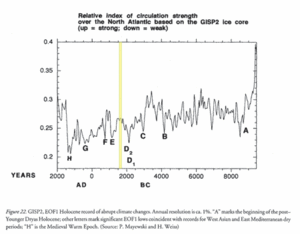
|
| ©Weiss, et al. |
This is not to say that the eruption that killed thousands wasn't an awe-inspiring event, but it looks more and more like it had simply a regional impact, mostly on the political systems, but hardly any major impact on the global climate, perhaps reducing the global temperature a degree over the next year as happened with the Mt. Pinatubo eruption, before the dust settled - some of it in Antarctica.
Now, getting back to those other dates. Further on in her article, Ms. Knight-Jadczyk refers to another paper on the Antarctic ice cores.
Looking further: Michel R. Legrand and Robert J. Delmas of Laboratoire de Glaciologie et Geophysique de l'Environment published an article "Soluble Impurities in Four Antarctic Ice Cores Over the Last 30,000 Years" in Annals of Glaciology (10, 1988, pp 116-120). They graphed the Oxygen 18 variations and the ionic components Na = NH (sub4) and Ca (sup 2) and H and Cl and NO (sub 3) and SO (sub 4). The time scale for each ionic component level as well as the O (sup 18) levels stretches back 30,000 years. The graph shows correlations to spikes at 5,200 BC, 8,800 BC, 12,400 BC, c. 16,000 BC, c. 19,600 BC. All of these were times of great geologic stress.However, if you look at the figure (see fig. 1 from the paper below) that was used in determining the dates of this recurring event it isn't very clear at all that these things happened at the times quoted. The time scale (Years Before Present) are given at the top of the figure. One can see a ~12,400 - 13,000 BP event in the d180 plot, but not in any of the microparticles. There is no 5,200 BP event in the d18O plot, but what looks like a 6,000 BP event in two of the microparticle plots. It's hard to narrow down precisely the 19,600 BP event though there is something going on around the 20,000 BP event. Anyway, the point is that the authors do not mention specific events in the paper and it's hard for the reader to interpret the timing of the events from the figure.
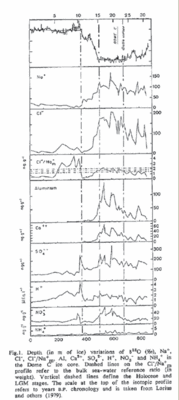
|
| ©Legrand, et al. |
This is not to say there isn't cyclic phenomenon, but the best way to figure this out isn't to subjectively look at a curve dating back 30,000 years and pick and choose dates. No, there's a better way. And there have been many papers and much data gathering since the Legrand paper came out. We now have data going back hundreds of thousands of years in both the Antarctic and Greenland ice cores. In fact, if you're trying to understand cycles and their impacts on Northern Hemisphere cultures it's best to stick with the Greenland ice cores.
Harvey Weiss, an archaeologist at Yale U. wrote an article in 2002 called Environmental Disaster and the Archaeology of Human Response.
The earliest Holocene abrupt climate changes occurred at 12,800, 8,200, 5,200, and 4,200 B.P. The 4200 B.P. abrupt climate change is especially well documented across West Asia, Central Asia, Africa, and parts of the New World. Limnological and speleothem radiometric dates situate the beginning of this event at ca. 3,800 radiocarbon years before 1950 (3.8 ka bp) or ca. 2200 B.C.The first thing to notice is that he does not even mention the 1628 BC Thera eruption event. In other words, it's impact was regional, mostly in the Mediterranean area. Another thing to notice is that precise dating pins down the timing of the events. The only date that matches the above dates is the 5200 BP event, otherwise, we have adjustments to the other events.
High resolution paleoclimate records, including the Greenland Ice Shee Project 2 (GISP2) ice core, Lake Van varve sediments, and U.S. Southwest dendrochronology, now also provide absolute calendar dating for this event in addition to quantification of its amplitude relative to prior and succeeding climate states. Social adaptations to this event are recorded in the contemporary archaeological records of southeastern Europe, North Africa, and West Asia: habitat-tracking, regional population abandonments, migrations, and sociopolitical collapse.
And as you can see, the 3600 year cycle is harder to discern. But has it disappeared? What seems to appear in its place, excluding the 5200 BP event, is a ~4200 year cycle. But, as I mentioned, we have data now going back hundreds of thousands of years so if there is a 3600 year or 4200 year cycle and it's been going on for a long time they should appear in this record.
There's a data analysis technique known as the Fast Fourier Transform (FFT) which basically extracts the spectral coefficients and returns the power of any cyclicity in the data passed through this mathematical filter.
Fig 2 shows the results of using FFT on the GRIP and NGRIP oxygen-18 isotope data. Before passing the data through FFT it was interpolated to yearly values. The NGRIP (left) data goes back 112,900 years, the GRIP data (right) 41760 years. And as can be seen in the GRIP FFT there's a rather strong signal at 4600 years, a broader, but slightly stronger signal centered around ~8200 years and a pronounced signal at 20,900 years.
For this type of data the errors on these signals increase as the period increases because the error is proportional to the number of cycles contained in the time period of the data. So for example the error for the 4600 years is 1/sqrt(N) where N=41760/4600 or 33% which is about 1500 years. For the largest period the error is quite high, but this signal is well known. It is one of the Milankovitch cycles, specifically the precessional periods of 19000, 22000, and 24000 years. There is a 3500 year cycle, but this isn't as strong a signal, being less than half the strength of the 4600 year signal and is thus not as important to the cyclic nature of the data, however it does exist, though its significance is questionable. The error on this is smaller still at 29% or +/- 1000 years.
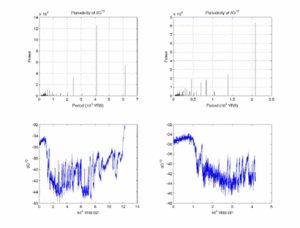
|
| ©Author |
| Fig. 2a) Left side shows Periodicity of longer NGRIP data. Right side shows periodicity of shorter GRIP data. |
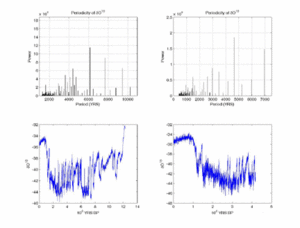
|
| ©Author |
| Fig. 2b) Left side shows Periodicity of longer NGRIP data. Right side shows periodicity of shorter GRIP data. Same as fig. 2a, but zoomed into higher periodicities. |
Looking at the longer time series from the NGRIP data we again see the precessional cycle more resolved at 25000 years and 20500 years. The larger signal at 41000 years is another Milankovitch cycle, the obliquity or axial tilt of the earth. The 61500 year signal is most likely picking up the 100,000 year eccentricity cycle given that the data set is only 112,900 years long and the error so large.
But what we're concerned with here are the shorter cycles. Because of the longer time series of the data (roughly a factor of three), the errors are reduced by roughly 1.7 (sqrt(3)).
As can be seen in the plot, there is a ~6000 year cycle which has been recognized in the Greenland ice core data ("A 6-ka climatic cycle during at least the last 50,000 years" [pdf]).
"[S]ignificant ice growth did, in fact, occur at around 6000 years BP. Studies of some of the largest of the 3000 small glaciers that occur in Fennoscandia today indicate that the majority of these started to grow shortly after 6000 years ago." The biblical flood of Noah is believed to date back to this time period.According to recent archaeological research the flooding of the Black Sea dates to this period:
In 1998, William Ryan and Walter Pitman, geologists from Columbia University, published evidence that a massive flood through the Bosporus occurred about 5600 BC. Glacial meltwater had turned the Black and Caspian Seas into vast freshwater lakes, while sea levels remained lower worldwide. The fresh water lakes were emptying their waters into the Aegean Sea. As the glaciers retreated, rivers emptying into the Black Sea reduced their volume and found new outlets in the North Sea, and the water levels lowered through evaporation. Then, about 5600 BC, as sea levels rose, Ryan and Pitman suggest, the rising Mediterranean finally spilled over a rocky sill at the Bosporus. The event flooded 60,000 mile² (155,000 km²) of land and significantly expanded the Black Sea shoreline to the north and west. Ryan and Pitman wrote:The next largest signal below 6000 is ~4300 years, and then, below that, a 3600 year cycle. A similar spectral analysis using the Lomb-Scargle periodogram (not shown) shows that the 4300 and 6000 periodicity are significant, but not the 3600 year cycle."Ten cubic miles [42 km³] of water poured through each day, two hundred times what flows over Niagara Falls. ...The Bosporus flume roared and surged at full spate for at least three hundred days."
So from the longer time series data we see a stronger, 4300 year cycle and an even stronger 6000 year cycle. These two (possibly three) cycles are unexplained. We do not know what causes them.
Or do we?
The answer is important for not only was there a global event 4200 years ago (and again at 8200 BP), there was one 6000 years ago (and again at ~12000 BP). On top of that, there was the rapid rise in sea level 19000 years ago and the associated warming of the North Atlantic region that began 21000 to 22000 years BP coinciding with the precessional cycle (see Rapid Rise of Sea Level 19,000 Years Ago and Its Global Implications[pdf]). Then there was an event 41000 years ago, possibly a supernova (Firestone, et al.), aligning with the obliquity cycle.
So we have four cycles, possibly five if you include the eruption of Thera as part of the 3600 year cycle, that are converging at the present moment. I believe my correction that it's a 4300 year cycle that we need to be most concerned about is the correct one, not a 3600 year cycle. Arguably, the 4300 year cycle could fit into the 41000 year cycle, but that wouldn't fit with the known solar forcing due to the obliquity cycle.
Just a quick look at the bottom plot from the wiki site (reproduced below) shows that if recent warm periods (or interglacials) are a guide, then we may soon slip into another glacial period and that whatever brings it about is due right about now as at least four cycles coincide to bring down global temperatures a few notches. The hype about global warming, (which preceded every glacial cycle for the past million years), is just mere distraction by comparison, because the bigger surprise is yet to come.
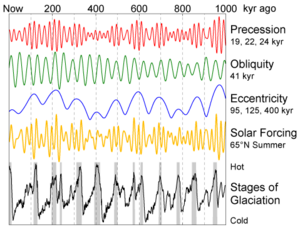
|
Now, getting back to the email, The Younger Dryas Impact Event. What's interesting about this story is that climate scientists, not being historians, archaeologists, astronomers or nuclear physicists (they're mostly geologists), tend to think that only the Sun influences the climate and that the Earth is pretty much a closed system that has periodic climate changes, probably due to the chaotic nature of the system. A comment by Dr. Peter de Menocal of Lamont-Doherty Earth Observatory pretty much sums up the views of paleoclimate scientists about the Holocene era:
"The archeological community - and actually segments of the paleoclimate community - have viewed the Holocene as being climatically stable... And so they imagine that the whole drama of civilization's emergence took place on a level playing field in terms of the environment."But a broader base of knowledge brought in by archaeologists, astronomers and nuclear physicists has rocked the boat and it has been going on for over a decade. A look at some of the abstracts presented at the meeting will give some flavor on how far things have come in the past few years:
Scientific Drilling, Impact Craters, Paleoclimate, and Mass Extinctions ; I D A Kring, Lunar and Planetary Institute; J Urrutia-Fucugauchi, Universidad Nacional Autonoma de MexicoKennett's abstract, Triggering of the Younger Dryas Cooling by Extraterrestrial Impact, reads:
Did a Bolide Impact Trigger the Younger Dryas and Wipe Out American Megafauna? A Skeptic's Reaction to an Intriguing Hypothesis.; Fiedel, S J
Geophysical evidence of an impact crater in northwestern South America; Hernandez, O
Exploring the Human Ecology of the Younger Dryas Extraterrestrial Impact Event; Kennett, D J, Erlandson, J M, Braje, T J , Culleton, B J
The Younger Dryas ET Impact Theory and Terminal Pleistocene Mammalian Extinctions in North America; Erlandson, J M ,Kennett, D J, Braje, T, Culleton, B
Triggering of the Younger Dryas Cooling by Extraterrestrial Impact; Kennett, J P, Becker, L, West, A
Evidence for an Extraterrestrial Impact Origin of the Carolina Bays on the Atlantic Coast of North America; Howard, G A, West, A, Firestone, R B,Kennett, J P, Kimbel, D, Kobres, R
Evidence for a Massive Extraterrestrial Airburst over North America 12.9 ka Ago; Firestone, R B, West, A,Revay, Z, Belgya, T,Smith, A, Que Hee, S S
Extraterrestrial Markers Found at Clovis Sites Across North America; West, A, Firestone, R B, Kennett, J P,Becker, L
The enigmatic Younger Dryas (YD) cooling episode (12.9-11.5 ka) is unique to late Quaternary deglacials; its timing is unexplainable by orbital forcing because Northern Hemisphere insolation was increasing at that time. The abrupt onset of YD cooling coincided with, and was likely partially in consequence of reduction in north Atlantic thermohaline circulation (THC).Fiedel's skeptical abstract reads:
Triggering of YD cooling has often been attributed to major diversion of freshwater outflow from the continental interior via newly opened outlets resulting from ice sheet melt-back. However, an alternative primary trigger for YD cooling is actively being sought because of problems related to the timing of outlet openings and the relative importance of the magnitude and timing of freshwater input into the ocean.
We present evidence in support of the hypothesis that the primary trigger for YD cooling may have instead been an extraterrestrial impact (the YD impact event) over northern North America at 12.9 ka.
This impact event is recorded in a diverse range of impact-related proxies within the widely distributed YDB layer that indicates continent-wide impact effects.
YD cooling likely resulted both from a combination of short-term atmospheric processes due to the impact itself that reduced solar radiation and from reorganization of ocean circulation. The hypothesis also posits that the impact caused partial destabilization of northern ice sheets and the opening of freshwater conduits; ice sheet melting due in part to the deposition of impact related dust (i.e. albedo) on the ice sheets; freshening of Arctic and northern Atlantic surface waters, and resulting strong reduction in north Atlantic THC. The impact hypothesis for YD triggering explains the timing enigma of the YD episode and is consistent with much existing data:
1) Abrupt and dramatic switch in Lake Agassiz outflow at 12.9 ka away from the Mississippi River's southern outlet to newly-opened outlets to the east and/or north;
2) A major and abrupt drop in ice-margin lake levels at precisely the time of the impact, based on the chronostratigraphy at Lake Hind and supported by Lake Agassiz sediment records;
3) Evidence at the onset of YD cooling in northern Atlantic and Arctic sediment cores of widespread IRD (during Heinrich event H0) reflecting ice-rafting armadas, freshwater discharges and reduced sea-surface salinity that resulted from the partial destabilization and melting of the ice sheet;
4) Evidence for an anomalous peak in Greenland ice sheet margin melting at the onset of the YD during a time of abrupt ocean and atmosphere cooling.
The YD impact event supports the concept that extraterrestrial impacts, even of such limited geographic extent, can significantly and abruptly affect global climate change.
Comparison of the YD event with other even larger meltwater outflow events of the last deglacial that had limited affects on the THC, suggests that the YD cooling was not triggered solely by salinity-driven ocean circulation changes. Instead, short-term climate pertubations due to the impact likely played a key role in triggering initial cooling that was reinforced or enhanced by the ocean circulation changes. Thus, the YD climate episode would not have occurred in the absence of the YD extraterrestrial impact event.
Perhaps there is credible physical evidence of a bolide impact in North America at 12,900 cal BP. However, several incongruous aspects of the paleoclimatic, archaeological, and faunal records of the Terminal Pleistocene must be addressed to allay skepticism about the hypothesis of dramatic effects upon humans or megafauna:While Fiedel's skeptical questions need to be answered, the appearance of a "black mat" and carbon spherules in the sediments scattered throughout North America , along with the Carolina Bays radiating from possible impact craters in Lake Michigan dating from this period is pretty convincing evidence that a comet or other bolide impacted over the Laurentide ice sheet approximately 12,900 years ago. And just recently this appeared in the news:
1) Paleoindian populations (e.g., Folsom, Dalton) thrived after the Younger Dryas (YD) onset;
2) megafauna, including giant sloths were wiped out in Florida, but medium-sized sloths in the Caribbean islands (including Cuba) survived into the mid-Holocene;
3) South American megafauna survived until at least 12,500 cal BP, probably longer; why was there not a synchronous extinction?
4) Late Pleistocene cold reversals in Antarctica and southern South America are not synchronous with the YD;
5) Bison and grizzly survived, and elk and moose expanded into North America in the Terminal Pleistocene-Early Holocene; why did they survive and thrive?
6) Mammoths survived on Wrangel Island and probably in pockets in Siberia well into the Holocene; why did the supposed impact in the Arctic not wipe them out?
7) Finally, the YD ended at 11,590 cal BP even more abruptly than it began (over less than a decade); does this require another impact? If not, why does the YD onset call for an extraterrestrial trigger?
Two geologists from Washington traveled to north-central Montana last week after an accidental discovery of what they believe is a "new" meteorite impact crater, located just southeast of Thornhill Butte. The Havre Daily caught up with the two St. Martin University students at Havre's Fifth Street Grind and Short Stop Thursday. The discoverers were on their way to a local laundry to dry their clothes, drenched in the previous day's rain, before heading back out in their home-built buggy, "the Mule" designed for rugged terrain.How about 12,900 years ago?
Joe D'Alelio and Gabriel Mainwaring of Shelton, Wash. said they had been using Google Earth to locate fossil hunting grounds when "dumb luck" led the satellite view to scan over a formation familiar, yet very exciting. "We zoomed in and saw it had the form of a meteorite impact crater," D'Alelio said. "We checked with the USGS (United States Geological Survey) and there was no record of it. The only one they have is south of the Missouri River about 200 miles. This one is located north of the DY Junction (Highways 66 and 191). You can see it from Highway 66.
We loaded up the Mule and headed out Monday and camped when we got to the crater. We studied the rim, the bowl and surrounding area and took samples." Much like Daniel Moreau Barringer, who proved the famous Meteor Crater in Arizona in 1902, D'Alelio and Mainwaring said they had not spent a full day before they knew the crater had been caused by meteorite impact.
"It's about a mile wide, rim to rim and the sandstone layers are upside down," D'Alelio said. "The white is on top from the impact. You can measure the red sandstone to see how thick it is and it tells you the age. We are guessing it hit between 10,000 to 50,000 years ago, which is relatively new."
You can see the crater here. Notice off to the right (Northeast). There appears to be another, larger, crater, but there's no way to know for sure from the satellite image. How many more, "relatively new" craters are left to be discovered?
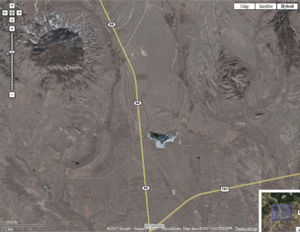
|
Firestone has written a book about this subject so I won't go into it here. New evidence of catastrophic changes appear in the science publications on a regular basis. The latest, A catastrophic meltwater flood event and the formation of the Hudson Shelf Valley. What is more, not only is it likely that Earth has been impacted by periodic comet swarms, these comet swarms are relatively new on the scene, geologically speaking. In a paper published in Science in March, 2000, titled "Lunar impact history from (40)Ar/(39)Ar dating of glass spherules",
Lunar spherules are small glass beads that are formed mainly as a result of small impacts on the lunar surface; the ages of these impacts can be determined by the (40)Ar/(39)Ar isochron technique. Here, 155 spherules separated from 1 gram of Apollo 14 soi l were analyzed using this technique. The data show that over the last approximately 3.5 billion years, the cratering rate decreased by a factor of 2 to 3 to a low about 500 to 600 million years ago, then increased by a factor of 3.7 +/- 1.2 in the last 400 million years. This latter period coincided with rapid biotic evolutionary radiation on Earth.And the same swarm that hit the moon surely struck the Earth which has a much larger area.
As Firestone has speculated, the sun is now moving through the outer arm of the Milky Way galaxy which is cluttered with debris, remnants of supernovas and this probably means much more frequent gravitational encounters with errant stars able to perturb the Oort cloud or even be captured by our own sun.
The most dramatic increase corresponds to the time of the dinosaur extinction 65 million years ago, and it continues to this day at a higher level than for most of the last 3 billion years. Clearly, the moon has been under a major meteor and comet assault in recent times, and this means that Earth has suffered from the same fate. According to Muller's research, we are still at one of the highest levels of bombardment that the Earth has seen in the last 3 billion years. There is absolutely no evidence that it is over; instead all the evidence suggests that it is continuing. [Richard Firestone, The Cycle of Cosmic Catastrophes p. 248]
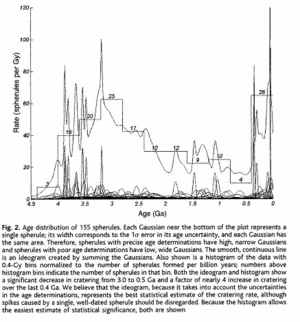
|
| ©Culler, et al. |
There's an oft cited excerpt from "Critias" by Plato (c.428 - c.347 BCE) in which he describes an encounter by Solon, his ancestor, with an Egyptian priest. It's worth repeating here:
Critias: Then listen, Socrates, to a strange tale, which is, however, certainly true, as Solon, who was the wisest of the seven sages, declared. He was a relative and great friend of my great-grandfather, Dropidas, as he himself says in several of his poems; and Dropidas told Critias, my grandfather, who remembered, and told us, that there were of old great and marvelous actions of the Athenians, which have passed into oblivion through time and the destruction of the human race and one in particular, which was the greatest of them all, the recital of which will be a suitable testimony of our gratitude to you....Plato goes on to write about Atlantis. But that is another tale... What's important here is that the Egyptian priest tells Solon that the myth reflects actual astronomical cycles of destruction and that they did not believe the myth as literal fact, but what it in fact represents.
[...]
Now, the citizens of this city are great lovers of the Athenians, and say that they are in some way related to them. Thither came Solon, who was received by them with great honor; and he asked the priests, who were most skilful in such matters, about antiquity, and made the discovery that neither he nor any other Hellene knew anything worth mentioning about the times of old.
On one occasion, when he was drawing them on to speak of antiquity, he began to tell about the most ancient things in our part of the world--about Phoroneus, who is called 'the first,' and about Niobe; and, after the Deluge, to tell of the lives of Deucalion and Pyrrha; and he traced the genealogy of their descendants, and attempted to reckon how many years old were the events of which he was speaking, and to give the dates.
Thereupon, one of the priests, who was of very great age; said,
'O Solon, Solon, you Hellenes are but children, and there is never an old man who is an Hellene.'
Solon, hearing this, said, 'What do you mean?'
'I mean to say,' he replied, 'that in mind you are all young; there is no old opinion handed down among you by ancient tradition, nor any science which is hoary with age. And I will tell you the reason of this: there have been, and there will be again, many destructions of mankind arising out of many causes.
There is a story which even you have preserved, that once upon a time Phaethon, the son of Helios, having yoked the steeds in his father's chariot, because he was not able to drive them in the path of his father, burnt up all that was upon the earth, and was himself destroyed by a thunderbolt.
Now, this has the form of a myth, but really signifies a declination of the bodies moving around the earth and in the heavens, and a great conflagration of things upon the earth recurring at long intervals of time: when this happens, those who live upon the mountains and in dry and lofty places are more liable to destruction than those who dwell by rivers or on the sea-shore; and from this calamity the Nile, who is our never-failing savior, saves and delivers us.
Getting back to the present; Laura Knight-Jadczyk writes concerning the sudden appearance of new moons orbiting Neptune, Saturn and Jupiter:
[T]o get back to our conversation about humanity being past its "extinct by" date, I mused that anybody with eyes and ears and a bit of scientific knowledge can look around and see that something is going on "out there".There was another article recently by Alexander Cockburn, perhaps the only liberal writer out there speaking against "global warming" or the idea that man is the cause of it. He writes:
The problem is, of course, that the masses of humanity are so distracted by all the concerns of everyday life - many of which are quite serious nowadays, especially the threat of nuclear war brought to us by George W. Bush and the Ziocons - that most of them haven't got a clue that they probably don't have to worry about Global Warming. (And just because I say that people don't have to worry about Global Warming doesn't mean they don't have to worry!)
The evidence that is all around us nowadays even helps us to realize that there was nothing really magical or mysterious about the story of Noah. The Bible tells us that God told Noah that something was up, something was coming, and that he should build an ark and that would enable him and his family and a few critters to survive.
But obviously, in this day and time, we really don't need God to tell us that Something Wicked This Way Comes..
In any event, what is perfectly clear is that the story of Noah and the story of Atlantis are apocryphal: many groups of people survived the event of 12,000 years ago here and there, and very likely many of them survived because they realized what was coming. Afterward, in their stories and legends they ascribed their survival to the intervention of their particular deity to give that deity more authority.
We should never be more vigilant than at the moment a new dogma is being installed. The claque endorsing what is now dignified as "the mainstream theory" of global warming stretches all the way from radical greens through Al Gore to George W. Bush, who signed on at the end of May. The left has been swept along, entranced by the allure of weather as revolutionary agent, naïvely conceiving of global warming as a crisis that will force radical social changes on capitalism by the weight of the global emergency.Now, some of the facts Mr. Cockburn confuses, but the gist of his article is correct (see comments in above link). What is happening is that the controllers are using Global Warming as a distraction to consolidate their hold on the public, the economy and now even the military:
Amid the collapse of genuinely radical politics, they have seen it as the alarm clock prompting a new Great New Spiritual Awakening.
Alas for their illusions.
Capitalism is ingesting global warming as happily as a python swallowing a piglet. The press, which thrives on fearmongering, promotes the nonexistent threat as vigorously as it did the imminence of Soviet attack during the cold war, in concert with the arms industry. There's money to be made, and so, as Talleyrand said, "Enrich yourselves!"
A secret report, suppressed by US defence chiefs and obtained by The Observer, warns that major European cities will be sunk beneath rising seas as Britain is plunged into a 'Siberian' climate by 2020. Nuclear conflict, mega-droughts, famine and widespread rioting will erupt across the world.Of course, it didn't prove humiliating at all to Bush. In fact, it played right into his hands as he has subsumed even more power like the python swallowing the piglet.
The document predicts that abrupt climate change could bring the planet to the edge of anarchy as countries develop a nuclear threat to defend and secure dwindling food, water and energy supplies. The threat to global stability vastly eclipses that of terrorism, say the few experts privy to its contents.
'Disruption and conflict will be endemic features of life,' concludes the Pentagon analysis. 'Once again, warfare would define human life. The findings will prove humiliating to the Bush administration, which has repeatedly denied that climate change even exists. Experts said that they will also make unsettling reading for a President who has insisted national defence is a priority.
The report was commissioned by influential Pentagon defence adviser Andrew Marshall, who has held considerable sway on US military thinking over the past three decades. He was the man behind a sweeping recent review aimed at transforming the American military under Defence Secretary Donald Rumsfeld.
Climate change 'should be elevated beyond a scientific debate to a US national security concern', say the authors, Peter Schwartz, CIA consultant and former head of planning at Royal Dutch/Shell Group, and Doug Randall of the California-based Global Business Network.
An imminent scenario of catastrophic climate change is 'plausible and would challenge United States national security in ways that should be considered immediately', they conclude. As early as next year widespread flooding by a rise in sea levels will create major upheaval for millions.
As I wrote at the beginning of this article, "If we can't stop an asteroid or comet from hitting us, do you think they'll panic the public by announcing an impending collision beforehand?" Nevertheless, panicking the public is de rigeuer for the Powers That Be, but only for those things they can manage. Global warming that would slowly play out over decades is the ideal problem for those seeking power: the ever more dire warnings feed into the controllers' hands as they use it to justify ever higher military spending, dismantling of civil liberties, more control for corporations, and "pre-emptive" invasions in the quest for dwindling resources. What the public doesn't realize is that this may very well be all in preparation for when that first comet swarm panics us little earthlings who have no underground bases, no stockpiles of supplies, no protocol for surviving such an event, to emerge on the other side still in control.
Whether it's a 3600, 4200, 6000, 20,000, 41,000 year cycle and that it was 3600 or is 4200, 6000, 12,000, 20,000, or 41,000 years ago doesn't make any difference to our "extinct by" date. As I noted above, the cycles are converging and the time is now. Indeed, Something Wicked This Way Comes.
If humanity could wake up to what is really in store for us, they might be able to throw off the ideological and cultural baggage strapped to us from our first breath and stop feeding a system run by psychopaths all too happy to enslave us with the yoke of fear and perpetual war and DO something.
And that's what They fear.




Very informative article. Rather fascinating how the 'public' mainstream sciences appear to be approaching a rather timely understanding about the effect of cometary impacts at this juncture. They are merely playing 'catch-up' at this point, of course - but at least some realizations are dawning at some level. I suppose when the next impact becomes evident, they will have one of those 'recognition' moments. Too bad it will be too little too late and that they'll probably never realize that the 'not public' scientists of the PTB had this one pegged long ago.